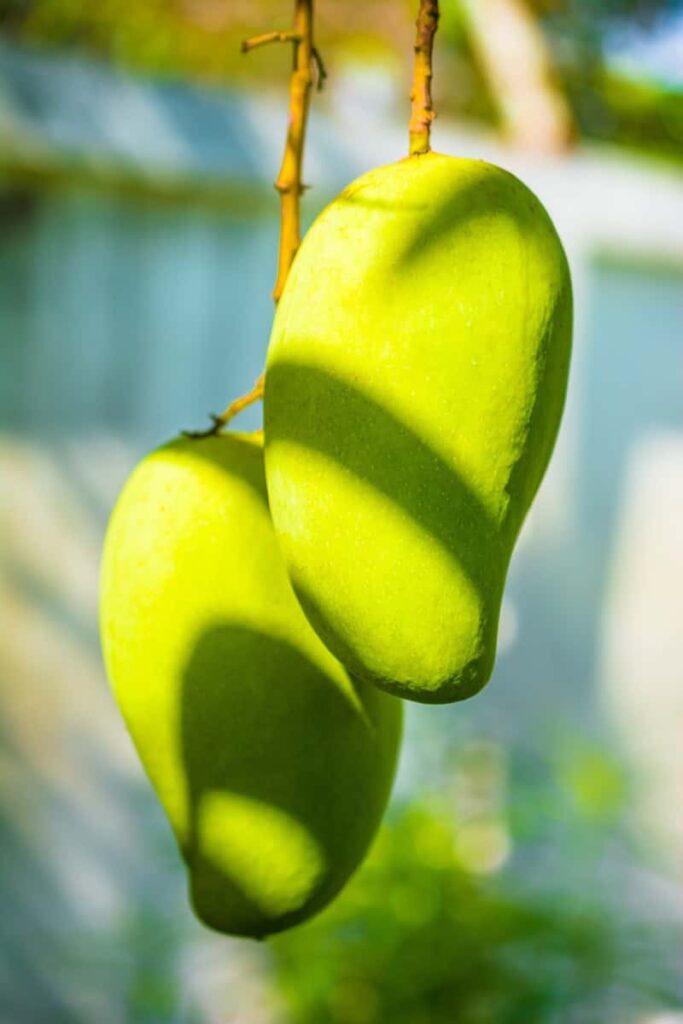Dashehari mango was introduced in the country by the Portuguese in the 15th century. Today, India is the largest producer of mangoes, contributing to over 50% of the world’s total mango production. Mangifera indica, the scientific name for Dashehari mangoes, is an Indian variety member of the Anacardiaceae family. One of the oldest and most revered types in Northern India.
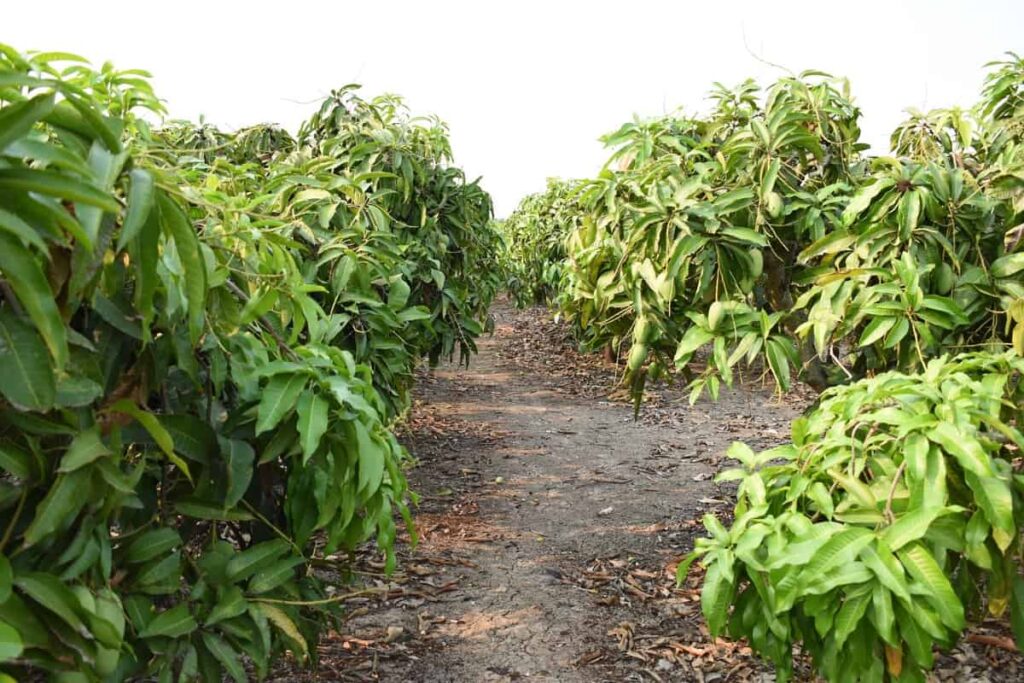
Dashehari mangos are a popular seasonal summer fruit used in raw and prepared recipes. They are known for their sweet flavor and juicy, smooth flesh. The Dashehari mango is also known by the regional names Dusari, Dashehari, Dusehri, and Dashehari. In India, Dashehari mangoes are renowned for helping to create new mango varietals. Due to its superior growth traits, the fragrant cultivar was chosen as the parent fruit of several mango varieties in Northern India, including Mallika and Amrapali.
Dashehari Mango farming in India
The name Dashehari comes from
Some of the oldest mango trees in the country can be found in Malihabad, the mango capital of India. The Indian government recognized Malihabad as the hometown of the Dashehari mango by giving it a Geographical Indication. Located in a grove near Dasheri Village, the mother Dasheri tree is over 200 to 300 years old.
Due to a tax dispute between mango growers, a pile of mangoes was abandoned in the village. Eventually, the mother Dasheri mango tree sprouted from the decomposing fruits. Eventually, the Nawab of Lucknow owned the mother tree for his consumption due to its excellent flavor and texture.
Characteristics of Dashehari mango
- Dashehari mangoes are small to medium-sized fruits, averaging 9 to 15 centimeters in length, and have an elongated, straight oval shape with blunt, curved ends.
- The skin is semi-thick, smooth, leathery, and subtly waxy, ranging in color from light green to yellow-green, transforming into a golden yellow hue when ripe.
- Underneath the surface, the orange flesh is tender, succulent, and almost entirely fibreless, encasing a moderately-sized stone.
- Dashehari mangoes are highly aromatic and bear a tropical, nectar-like scent. The fruit’s flesh is sweet and contains tropical, fruity, and mildly tangy nuances.
- It is a regular-bearing crop. It gives an average yield of 150kg of fruits per tree.
- Dashehari-cultivated states in India: Bihar, Gujarat, Haryana, Himachal, Madhya Pradesh, Punjab, Rajasthan
In case you missed it: How to Control Pests and Diseases in Mango: Causes, Symptoms, Chemical, and Biological Management
Soil required for Dashehari mango cultivation
Mangoes grow well in all types of soils. However, the primary soil requirement must be well-drained and deep. Red, loamy soil is the most ideal for mango cultivation. However, they can grow in alluvial, clayey, or laterite soil in India. The soil must have rich organic content and a good water-retaining capacity. Soils that do not have a good draining facility are not ideal for mango plantations. They grow on plains rather than hills.
Cultivation in hilly areas can lead to very low yields as the drainage, and climatic conditions are not best suited for mango cultivation. Soils with a good amount of iron peroxide and 5-10% lime are ideal for producing the best quality mango fruits. Fruits produced in such soil conditions have a bright red tinge. The ideal soil for mango is red loamy. Good drainage is preferable for better establishment. The ideal pH range is from 6.5 to 8.0.
Climate and temperature required to cultivate Dashehari mango
The mango tree will flowers and fruits during the dry season are characterized by the absence of rainfall. Rain or cloudy weather at the flowering time causes considerable damage to mango as it adversely affects flowering and fruit set and increases the incidence of pests and diseases. It grows where the temperature drops as low as 0°C and as high as 46°C. However, it thrives best at a temperature of around 27°C. It grows well both in low (25 cm) and high (250 cm) rainfall areas. However, with an annual rainfall of around 75 cm, it grows without irrigation.
The season for the Dashehari mango plantation
Usually, the timing for planting mango seeds varies, although it depends on the amount of rainfall the particular area receives. They are planted at the end of the rainy season in places with ample rainfall. Then, planting is done during February and March in irrigated areas. Lastly, in the rain-fed area, the planting is done in July- August.
Method of sowing
Square and hexagonal planting can be adopted. However, hexagonal planting accommodates 15% more plants.
Numbers of plants required for one acre
| Cultivar | Planting distance | Square system | Hexagonal system |
| Dasehari | 9m × 9m | 121 | 143 |
Land preparation and planting
Dig pits of 1 x 1 x 1 m at a distance of 9 x 9 meters at the plant site in summer. Pits are filled with topsoil and 5 to 6 baskets of Farm Yard Manure (F.Y.M.) and 2.5 Kg. Super Phosphate. To avoid termite attack, 100 gm of 10 percent carbaryl or chlordane dust is mixed in the pit. Only well-sized healthy plants should be lifted from the nursery. Care should be taken to lift 80 percent of the feeder root and tap root system in an earth ball. The earth ball should not be too big to break during transportation.
The plants should be brought from distant nurseries in 30 X 15 cm plastic bags. Some quality soil and farm yard manure mixture may be placed in each bag before placing the lifted earth ball in the bags. It is better than trash/grass used for wrapping the earth balls. If it is impossible to get polythene bags, containers (plastic/wooden) or crates should be used to pack the plants. This will help in checking the breakage of earth balls during transportation.
Remove the packing material gently and place the earth ball in the center of the prepared pits. The upper surface of the earth ball should be level with the soil in the field. The plants should not be planted too high or too low in the prepared pits. Press the sides of the newly-planted plants carefully without pressing the original earth balls. Apply light irrigation immediately after planting and level the surroundings in ‘water’ conditions.
Irrigation requirements in Dashehari mango cultivation
Water is life for young plants. Light and frequent irrigations give better results than flooding after long intervals. Irrigation interval depends upon the soil type, climate, and source of irrigation. The young mango plants should be kept at field capacity (‘Wattar’) during summers by applying irrigation at 5-7 days intervals. Increase this interval slowly to 20 days as the winter starts.
During the rainy season, avoid irrigation. However, if intercrops are being grown, provide a separate irrigation system to provide irrigation to the mango plants during April when wheat does not require any irrigation. Under North Indian conditions, bearing trees should apply irrigation one week before flowering and then after fruit set. During winter, the irrigation interval may be over 25-30 days. Proper moist conditions should be kept from April to October.
In case you missed it: High Yield Hybrid Mango Varieties in India: State Wise Growing Guide
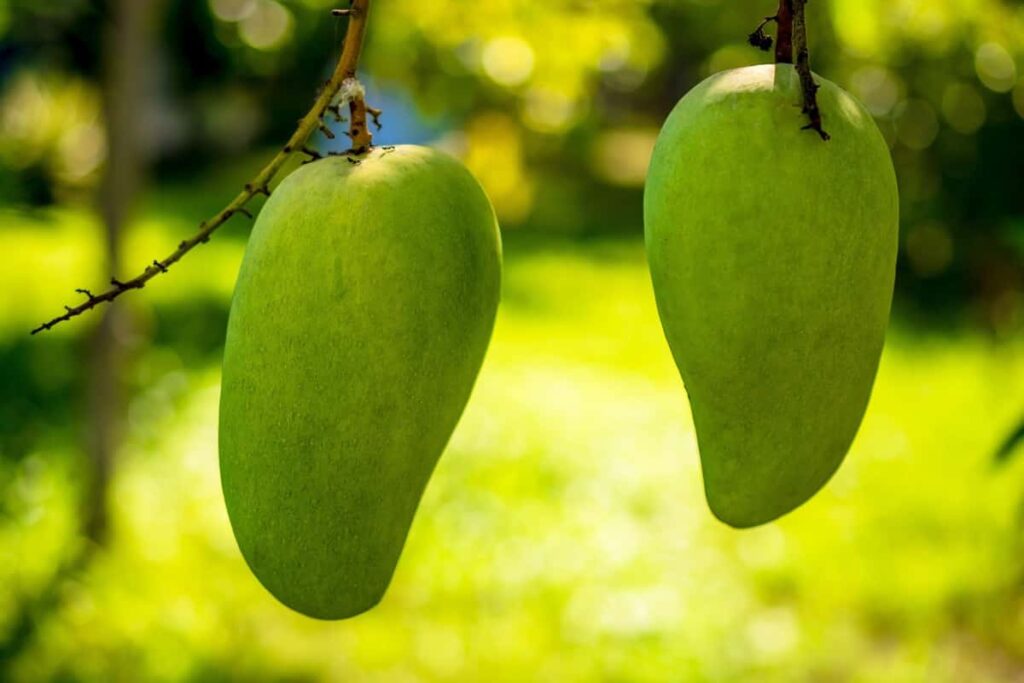
Manuring and fertilizers application in Dashehari mango cultivation
Fertilizer application for mango cultivation depends on the age of the plants. Therefore, the dosage varies during the nursery, establishment, non-bearing, and fruit-bearing periods. The dosage applied in the first year should be increased in multiples of the dose every year for the next ten years.
Fertilizing young trees
It is recommended that first-year mango trees receive 500 to 1000 grams of slow-release 10-20-20 fertilizer divided into three or four applications just before flushes of growth. During their second and third years, they should be given 700-1500 grams of 10-20-20 fertilizer applied similarly.
The fertilizer is spread directly beneath the leaf drip line and watered into the soil. Any complete fertilizer containing 6 to 10 percent nitrogen, 6 to 10 percent phosphorus, and 4 to 6 percent magnesium is appropriate for young mango trees. However, take care not to apply too much fertilizer to young trees.
Fertilizing mature trees
It is recommended that 450 grams of complete, slow-release fertilizer annually for each inch of trunk diameter 4 to 5 feet above the ground. Half of this fertilizer is applied before flowering, not during flowering, and the rest after the mangoes are harvested. Generally, fertilizers for bearing trees should contain 9 to 15 percent potassium, and Phosphorus should be reduced to 2 to 4 percent. Commonly available fertilizer mixes that are satisfactory for mango trees include 6-6-6 and 8-3-9-2, the 2 indicating magnesium.
Additional rapid-release fertilizers containing Nitrogen are applied just before mango trees flower to encourage flowering and mango yield. Generally, fertilizers are applied in two doses. One-half is applied immediately after harvesting the fruits- during June and July. The other half is applied in October. This is done for both old trees and young saplings. Irrigation follows if there is no rain. Before flowering, 3% urea is applied in the case of sandy soils.
Deficiency symptoms of essential elements in Dashehari mango cultivation
Nutrition of mango is an important orchard management practice. Canopy development and bearing are both dependent upon nutrition. Both excess and deficiency symptoms are given below.
In case you missed it: Organic Foxtail Millet Farming: Production and Management Practices for Beginners
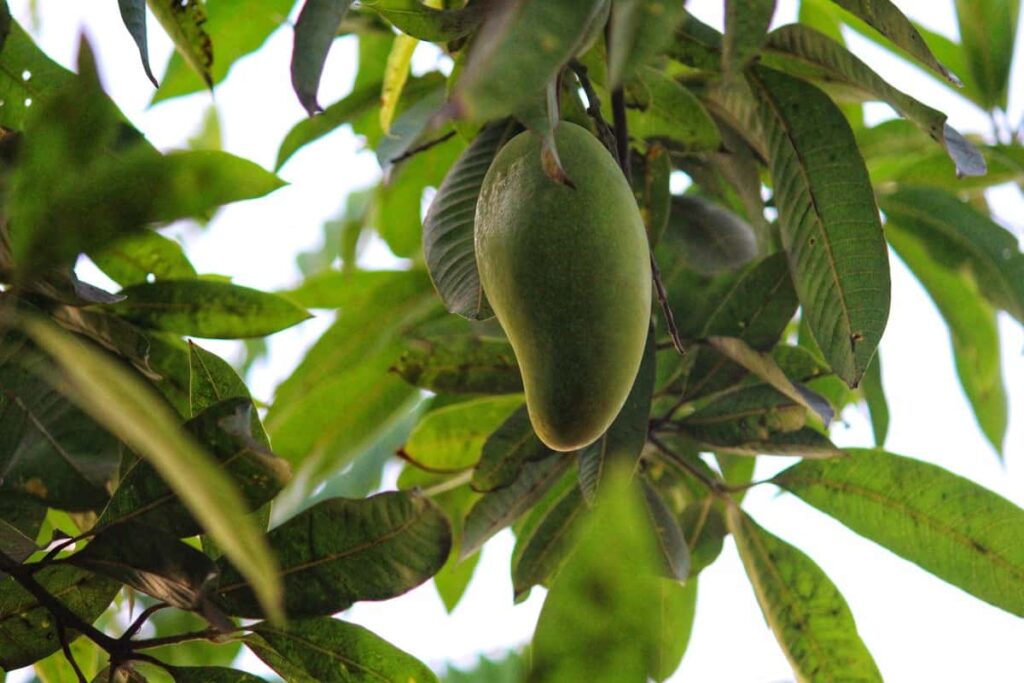
Nitrogen (N)
A deficiency of Nitrogen causes stunting in plants. The leaves become light green and do not attain full size. The old mature leaves become yellow. The flush length is reduced. In bearing trees, the number of flushes is reduced, and fruit size decreases with the severity of deficiency.
Phosphorus (P)
Phosphorus-deficient plants show severe stunting of growth. Leaves may fall prematurely. Branches show die-back symptoms. High Phosphorus causes the burning of old leaves, which starts from the margins and progresses towards mid-rib, leading to leaf fall and then drying of branches.
Potassium (K)
Potassium deficiency appears on semi-old leaves, usually in the middle of the shoots. Purplish discoloration of the leave starts with mild deficiency, and intensity increases with the severity of deficiency. Finally, the leaf showing necrosis progresses on the more mature leaves. No toxicity of K excess has been observed in North Indian mango orchards.
Calcium (Ca)
No typical deficiency pattern on leaves has been observed. However, plants remain stunted. The addition of Superphosphate as phosphatic fertilizer takes care of calcium also. Sufficient Ca is present in Superphosphate.
Magnesium (Mg)
Deficiency symptoms appear on mature leaves. Lamina starts yellowing from the margins, and dark green bands on both sides of the mid-rib are clearly seen. The deficiency can be checked by spraying magnesium sulfate at 2g/L of water at a flush time from May to July.
Sulfur (S)
Sulfur deficiency is very difficult to detect under field conditions. Plants with sulfur deficiency show similar behavior to those with nitrogen deficiency. The growth of plants is slow. Sulfur-deficient leaves show yellowing of young leaves and scorching of the lamina margins. The sulfur content of gypsum and Superphosphate is sufficient for mangoes.
Intercrops/ cover crops
In young orchards, vegetables and other low-growing crops like groundnut, black gram, green gram, and cowpea are grown as intercrops or cover crops. Cultivation helps to check the weed and improves the growth of the trees, besides giving some income to the growers till mango plants start bearing 4-5 years after planting.
Training and pruning
Rootstock sprouts and low-lying branches have to be removed. Remove overlapping, intercrossing, diseased, dried, and weak branches in old trees to get good sunlight and aeration. For the internal branches, pruning may be done from August to September, once in three years. Flowering should not be allowed for up to three years. Among crowded terminal shoots, weak shoots are trimmed to retain two healthy shoots during August-September annually.
Major pests in Dashehari mango
Mango Mealy Bug
Damage symptoms
- It attacks the plants during the flowering and fruiting stage from January to April.
- Its males are not harmful, but females lay eggs in the soil. Many nymphs crawl up the tree and assemble on the growing shoots and panicles.
- Nymphs and females suck the sap from shoots and panicles, and the inflorescences dry up.
In case you missed it: Barnyard Millet Farming: Production and Cultivation Practices, Planting to Harvesting, and Yield
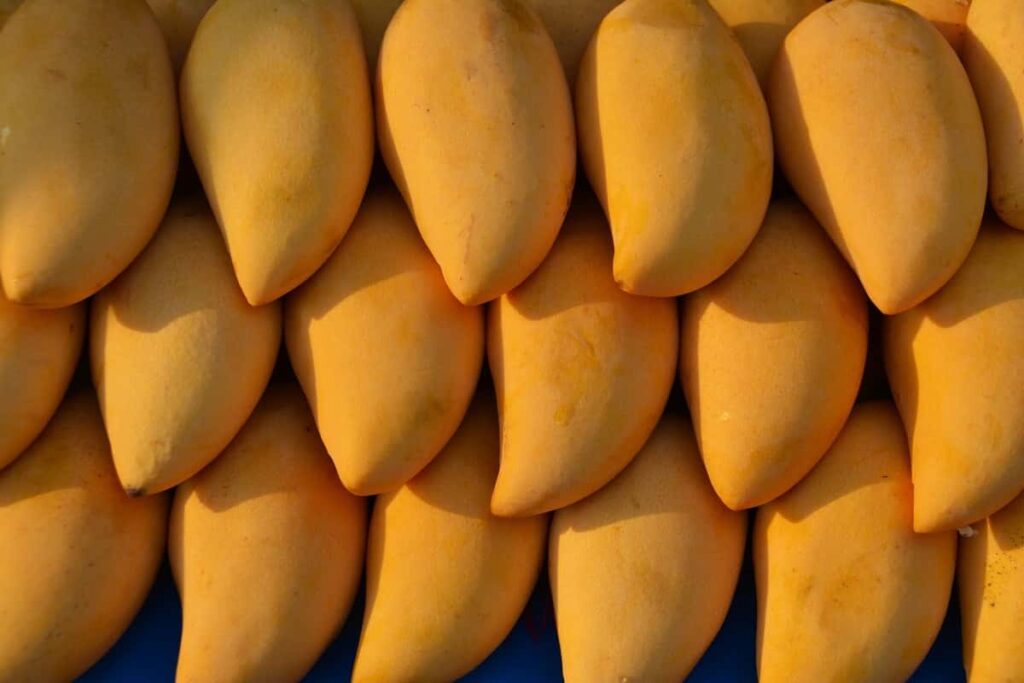
Control and management
- Nymphs can be prevented from crawling up to the tree trunks by applying a 20 cm wide sticky band with greasy/slippery material.
- The nymphs congregating below the band/sheet are mechanically killed or sprayed with methyl parathion 50 E.C. at two ml/L of water.
- Soil application of toxaphene at 225 gm/tree has been very effective.
Mango hoppers
Damage symptoms
- Several nymphs and adults attack tender leaves and emerging inflorescences and suck cell sap.
- Due to sap-sucking, the inflorescences wither away, turn brown, and flowers drop off. Severely infested trees show retardation of growth.
- In addition, hoppers excrete honeydew on which sooty mold develops, which affects the photos3nithetic activity in plants.
Control and management
- Mango hoppers can also be reduced by up to 60% with sprays based on neem oil (3%). Two to three times a week is recommended for treatment.
- The sprays that contain cypermethrin (0.4%), which is highly effective, should be used.
- Dimethoate-containing insecticides can be sprayed or injected into the trunk. It is recommended to spray two times before flowering begins seven days apart to reduce the side effects on pollinators.
Mango Fruit Fly
Damage symptoms
- The females lay eggs just below the epidermis of the young fruit.
- The larvae from the eggs start feeding on the pulp. Thus, a brown patch with resinous material is seen on the peel.
- Fruits start rotting and dropping. Infested fruits are unfit for human consumption.
Control and management
- Hang traps containing 100 ml emulsion of methyl Engenol 0.1 percent. Malathion during the fruit development period (April-June) under North Indian conditions.
- Give three sprays of chlorpyriphos 20 E.C. at two ml/L of water at 20 days intervals starting from 1st May.
- Dip fruits in a 5 percent sodium chloride solution for one hour to kill eggs and remove insecticide residue.
Major diseases in Dashehari mango
Powdery Mildew
- It is characterized by white superficial powdery fungal growth on leaves, panicle stalks, flowers, and young fruits.
- The affected flowers and fruits drop prematurely, reducing the crop load or preventing fruit set.
- A fungus parasitizes the young tissues of all parts of the inflorescence, leaves, and fruits.
- Young leaves are attacked on both sides, but the grower’s surface is more noticeable. It is common for these patches to coalesce and occupy larger areas, taking on a purplish-brown color as well.
Chemical control and management
- Spray Karathane at 1.0 gm/liter or wettable sulfur at 2.5 gm/liter when the panicles emerge. Repeat the spray after 20 days.
- Give another spray if a powdery mass is seen on young fruits and their pedicles.
Gummosis
Damage symptoms
- The disease is characterized by the profuse oozing of gum on the surface of affected wood, bark of the trunk, and larger branches but is more common on the crack branches.
- In severe cases, droplets of gum trickle down on the stem, and the bark turns dark brown with longitudinal cracks.
Chemical control and management
- The disease can be controlled with regular sprays of copper-based fungicides.
- The diseased bark/portion should be removed, cleaned, and covered with copper-based fungicides paste.
- Application of copper sulfate 500g in the sandy soil around the tree trunk is also advocated.
Bacterial canker
- On leaves, minute water-soaked irregular to angular raised lesions is usually crowded at the apex.
- On young leaves, halos are larger and distinct, while on older leaves, they are narrow and can be observed only against light.
- Under severe infections, the leaf turns yellow and drops off.
In case you missed it: How to Start Dairy Farming in Cambodia: Key Rules, Business Plan, Breeds, Cost, Profit, License, and Management
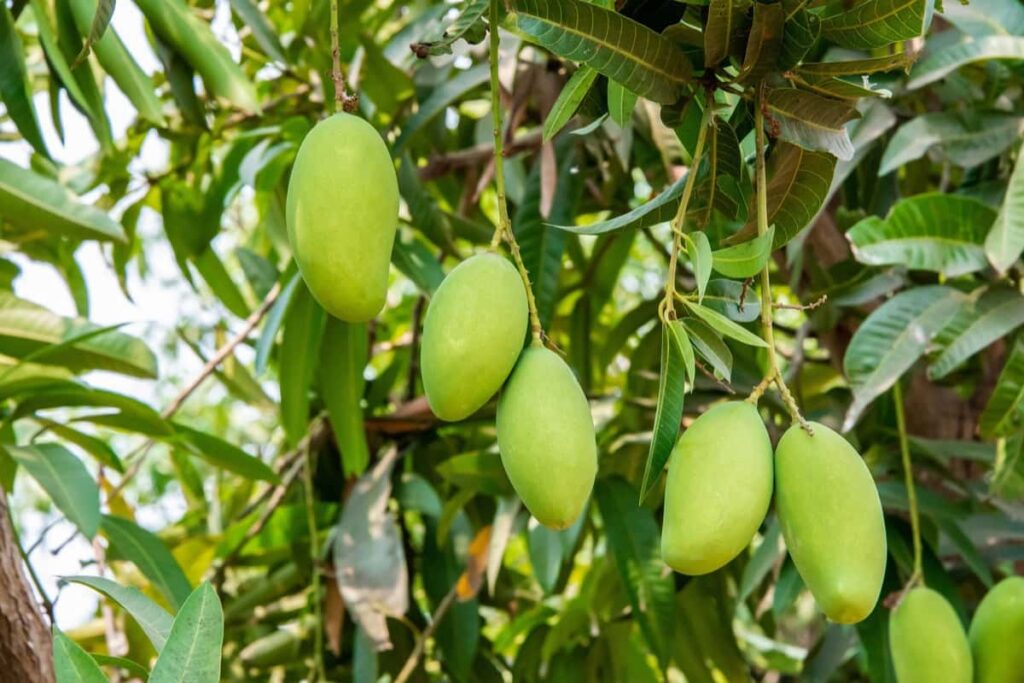
Chemical control and management
- Regular inspection of orchards, sanitation, and seedling certification are recommended as preventive measures against the disease.
- The spray of copper-based fungicides has been found effective in controlling bacterial canker.
Harvesting Dashehari mangoes
Mango trees start bearing fruits from the 5th year of planting. The yield, however, varies depending on the variety and climatic conditions. The first-year yields are generally low (3-5 Kg per tree), increasing gradually in subsequent years. Some trees aged 30-40 years can bear up to 600 Kg of fruits a year. Since mangoes continue to ripen even after they are plucked from the trees, they are commonly harvested at the early stage. Therefore, it is done to capture them early in the market.
First, the plucked fruits are graded based on their color, size, and stage of maturity. The smaller ones are separated from, the larger ones to attain uniform ripening. Fruits that are diseased damaged or overripe are discarded at this stage. Then, the fruits are cut by dipping them in 1.8 mL of ethrel in one-liter hot water for 5 minutes. In the case of mature fruits, the lower dose of ethrel dipping is done for uniform color formation. The mature fruits are stored for 4-10 days at room temperature. However, this depends on the variety.
Conclusion
Mango cultivation is a long-term investment, unlike many other crops. However, following the practice of ‘intercropping’ by planting turmeric, groundnut, various legumes, and apiculture would generate income for the farmer till returns from the fruits can be generated. Also, organic farming can increase the value of mangoes.
- Sheep Farming Business Plan for Beginners
- Aquaponic Farming at Home: A Step-By-Step Guide
- Profitable Village Farming Business Ideas in 2024
- High-Yield Aquaculture: Fast-Growing Fish for Farming
- Effective Fish Pond Construction Techniques for Beginners
- Irrigation and Water Management in Pineapple Farming
- Blossom to Harvest: Mastering Flowering and Pollination in Papaya Farming
- Pig Fattening Essentials: From Selection to Sale for Beginners
- Raising Wagyu Cattle: A Complete Guide for Premium Beef Production
- Soil Types and Their Water Holding Capacity
- Optimizing Irrigation Schedules for Coconut Groves for Enhanced Yield
- Espresso Your Garden: Coffee Grounds for Healthier Acid-Loving Plants
- The Best Soil Mix for Snake Plants: How to Mix Your Own Snake Plant Soil
- Green Thumb Success: Expert Tips for Cultivating Greenhouse Beans All Year Round
- Bloom All Year Round: The Ultimate Guide to Indoor Hyacinth Care
- Eco-Friendly Gardening: How to Make Liquid Fertilizer from Kitchen Waste
- Ultimate Guide to Grow Anise in Pots: Explore Seed Propagation to Harvesting
- Guide to Raising Chester White Pigs: Discover Breed Facts to Growth Management
- Mastering the Elegance: The Ultimate Guide to Weeping Cherry Tree Care, Planting, and Maintenance
- Ultimate Guide to Planting Garlic in Grow Bags: Growing Strategies for Beginners
- How to Fix Spider Plant Leaf-Related Problems: Natural and Organic Remedies
- 10 Reasons Why Your Tulsi Plant is Shedding Leaves: Home Remedies and Solutions
- Optimizing Growth and Yield: The Advantages of Palm Bunch Ash Fertilizer
- Utilizing Neem Oil Extract as a Natural Pesticide for Hydrangea
- From Soil to Harvest: Various Ways in Which Farmers Can Use AI Tools
- Steps to Encourage and Induce Citrus Flowers: A Comprehensive Guide
- How to Fix Snake Plant Leaf-Related Issues: Natural and Organic Remedies
- Transform Your Garden into a Fragrant Oasis with Raat Ki Rani (Night Blooming Jasmine)
- Discover the Ideal Chicken Breeds for Philippine Farms
- How to Create a Poultry Egg Farm Business Plan for Profits
- Grow Lemon Cucumbers Like a Pro: Insider Techniques for Bountiful Yields
- Ultimate Guide to Caring for Your Pink Princess Philodendron: Tips for Thriving Variegation
- Areca Nut Profit Per Acre: Calculating Yield and Cost of Cultivation
- How Kaveri Chicken is Becoming a More Profitable Breed in Indian Backyards
- Transform Your Barn: 9 Steps to Convert a Horse Stall into a Chicken Coop
- Exploring Suffolk Sheep Disadvantages with Limitations and Challenges

